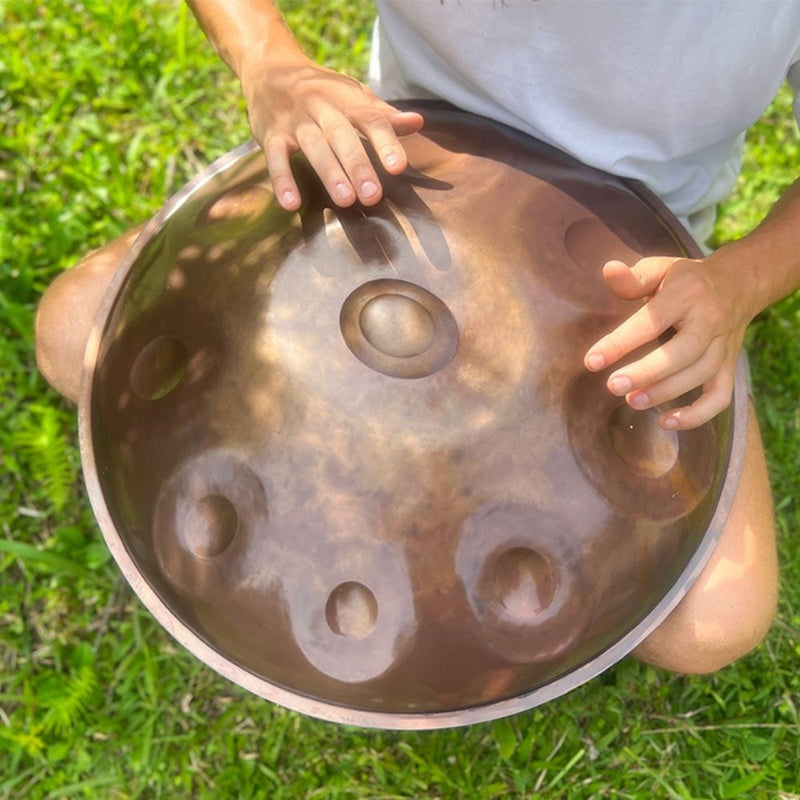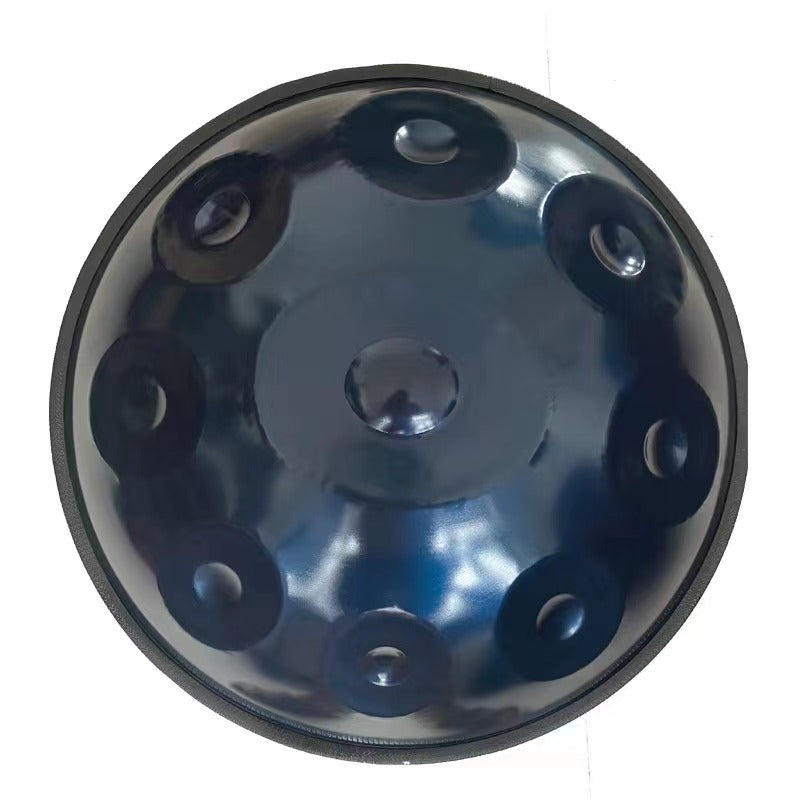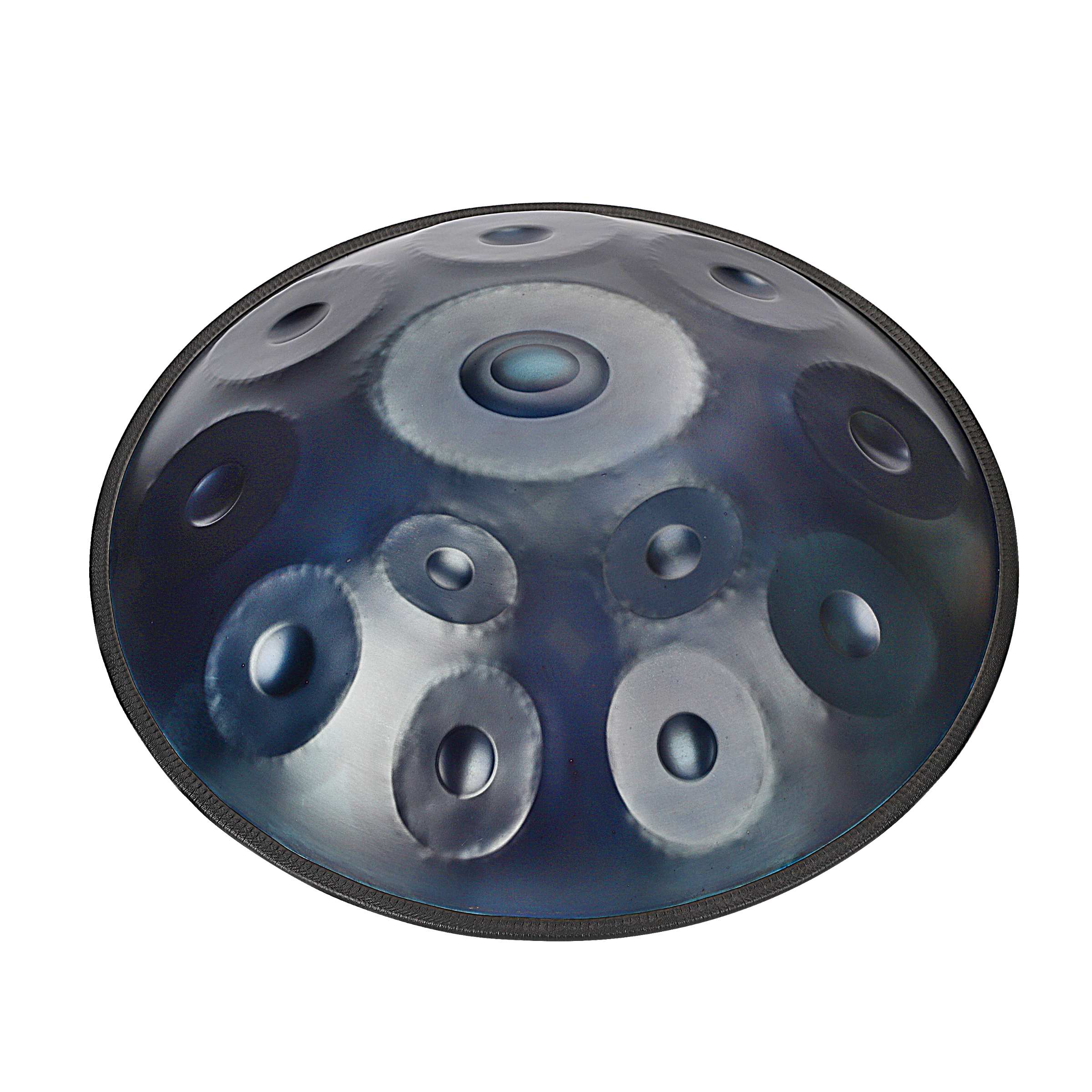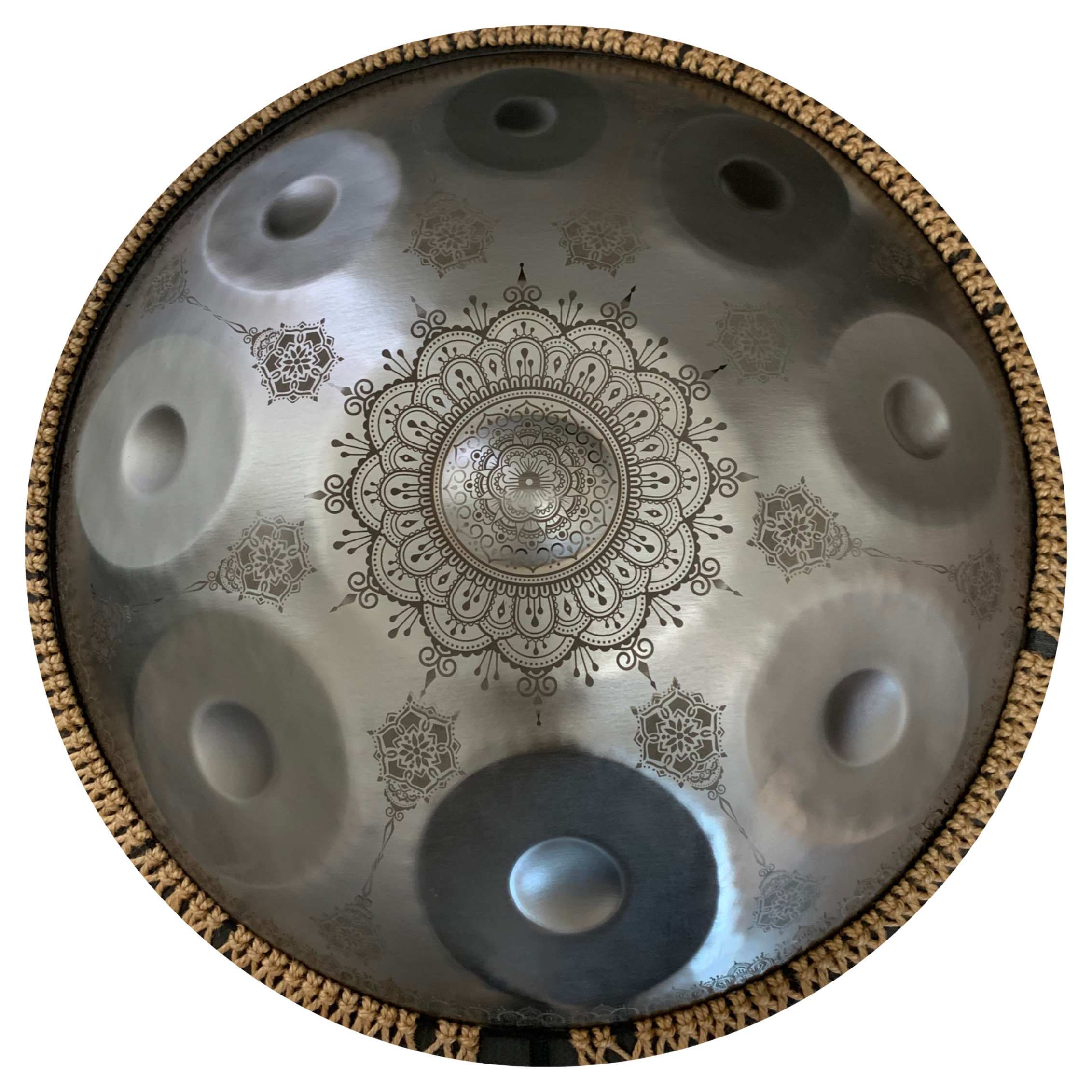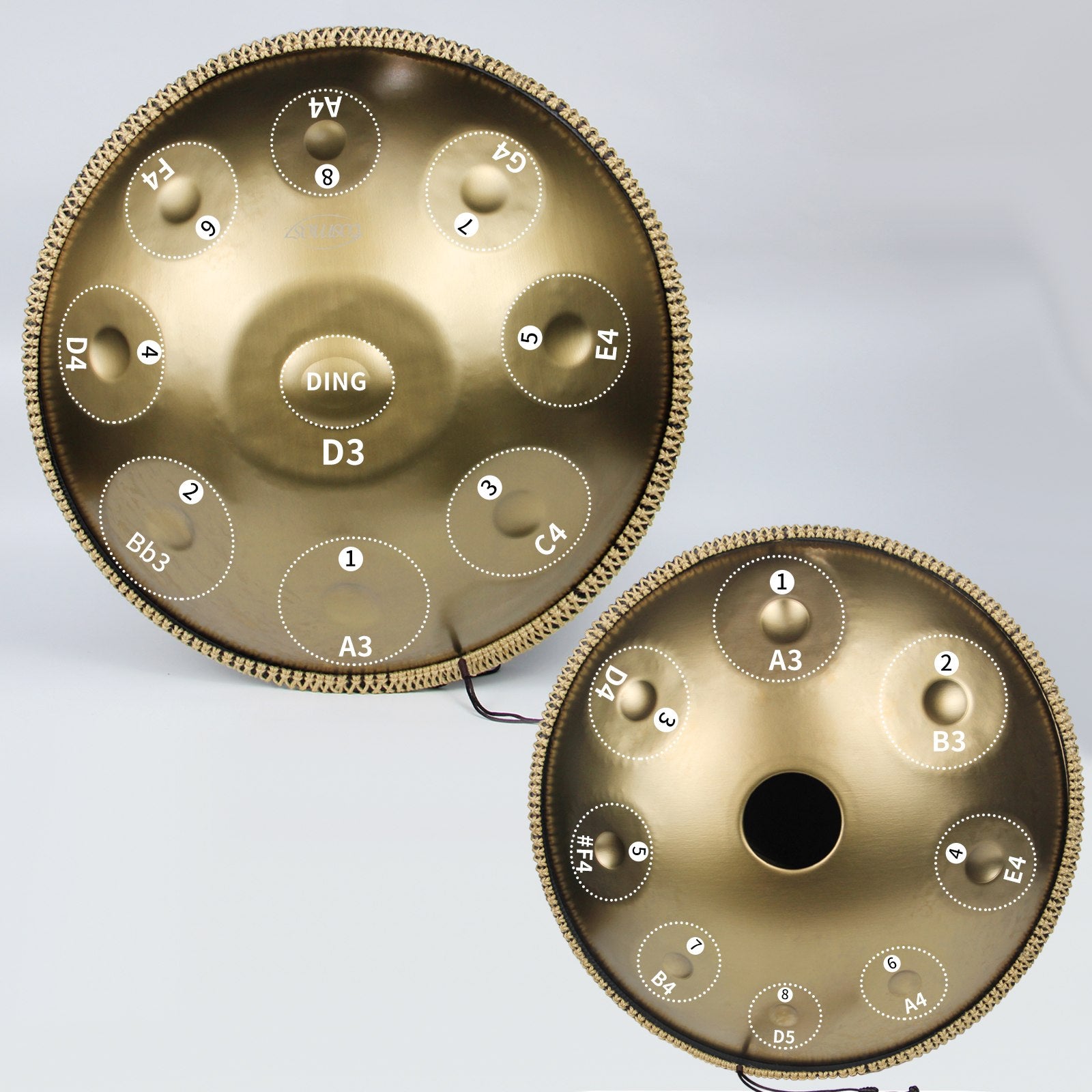Bevor wir einen Stahlzungen-Trommel mit einem Handpan vergleichen, ist es wichtig, die Merkmale, Vorteile und Unterschiede jedes Instruments zu erkennen. Die beiden Instrumente unterscheiden sich völlig in ihrem Klang. Gleichzeitig erzeugen sie beim Spielen völlig unterschiedliche Stimmungen und Erfahrungen. Hier ist ein Vergleich der Spezifikationen, der Ihnen helfen wird, die richtige Wahl eines Instruments zu treffen, das Ihren Bedürfnissen entspricht.

Bau und Tonproduktion
Handpans bestehen aus zwei erfolgreich verbundenen Metallhalbkugeln, die mit einem speziellen Kleber verklebt sind. Die obere Fläche der chinesischen Glocke ist mit mehreren Tonfeldern gestaltet, die um eine zentrale Kuppel angeordnet sind, die als Ding bekannt ist; diese speziellen Bereiche sind in bestimmte Tonhöhen gehämmert. Wenn diese Felder angeschlagen werden, vibrieren sie und erzeugen einen hellen, tiefen Klang, der eine Weile nachklingen kann. Der Prozess ist intensiv und sehr präzise, da das Metall etwa 2000 Hammerschläge benötigt, um korrekt gestimmt zu werden.
Tankdrums oder Stahlzungeninstrumente werden aus einem Stück Metall gegossen und enthalten eine Reihe von "Zungen", die in das Grundmetall eingeschnitten sind. Diese Zungen erzeugen Vibrationen, wenn sie angeschlagen werden. Das Design ermöglicht auch eine einfache Stimmung, häufig mit Magneten zur Stimmung, was zur Erzeugung des glockenähnlichen und meditierenden Musikmusters führt.
Größe und Tragbarkeit
Handpans sind größer und vergleichsweise schwer, wobei das Gewicht zwischen 7 und 10 Pfund liegt und die Größe einen Durchmesser von 20 Zoll hat. Dies macht sie empfindlicher beim Transport und bei der Lagerung. Stahlzungeninstrumente sind kleiner und messen ab 5. Mit Durchmessern von 5 bis 12 Zoll und einem Gewicht von 2 bis 10 Pfund sind Coolpercussion-Produkte tragbar und relativ einfach zu handhaben.
Spielbarkeit und Techniken
Handpans sind dafür gedacht, mit den Händen gespielt zu werden, sodass man die Dynamik des Klangs kontrollieren kann. Um verschiedene Töne und Rhythmen zu erzeugen, bewegen die Spieler ihre Finger, Daumen und Handflächen. Daher haben Sänger viel auszudrücken. Die großen Notenköpfe ermöglichen viel Geschwindigkeit und eine moderate Komplexität der Musik, ohne versehentlich benachbarte Töne zu treffen.
Was die Spielweise von Stahlzungeninstrumenten betrifft, können Sie Hände oder Schlägel verwenden. Das Schwingen von Schlägeln ermöglicht es Anfängern, klarere, oft wiederholte Geräusche zu erzeugen. Es ist für neue Spieler einfacher, die gewünschten Töne zu treffen, was bei Instrumenten, die Percussion erfordern, hilfreich ist.
Außergewöhnliche Option von Magneten zur Neutuning macht sie für mehrere Musikarten geeignet.
Klang und Lautstärke
Handpans zeichnen sich dadurch aus, dass sie beim Spielen warme Töne erzeugen und einen perkussiven Klang von sich geben, gefolgt von einem langen harmonischen Nachklang. Sie sind lauter und daher perfekt für Solokünstler sowie für Gruppen und Orchester. Stahlzungeninstrumente hingegen, die einen tieferen Ton haben, bieten einen glockenähnlichen, reflektierenden Klang, der gut für nachdenkliche, ruhige Spieler und Aufführungen sowie für Räume und Umgebungen mit weniger Publikum resoniert.
Kosten und Wartung
Handpans sind kostspieliger als Hangdrums, da mehr Zeit und Mühe benötigt werden, um die Pan zu entwickeln und sie auf eine andere zu stimmen. Die meisten Handpans kosten zwischen 1.000 und 4.000 Dollar und mehr, abhängig vom Hersteller der Pan und der Anzahl der enthaltenen Töne. Aus diesem Grund ist es unerlässlich, sie häufig mit Hilfe von Fachleuten zu stimmen, damit sie hohe Klänge erzeugen.
Ein Stahlzungeninstrument ist relativ günstiger, während die hochwertigen Exemplare zwischen 100 und 500 Dollar kosten. Es ist einfacher, sie zu warten und zu stimmen, da die Zungen mit Magneten oder einem einfachen Instrument manipuliert werden können. Daher sind sie für Lernende, Gelegenheitsnutzer oder Personen mit einem begrenzten Budget geeignet.
Vielseitigkeit und Anwendungsfälle
Musikalische Handpans werden von Spielern gewünscht, die ein Instrument suchen, das sowohl als primäres als auch als sekundäres Instrument verwendet werden kann und das zudem variabel ist und in der Lage ist, viele verschiedene Rhythmen und Harmonien gleichzeitig zu erzeugen. Es ist fast unmöglich, den Einsatzbereich ihrer Verwendung zu spezifizieren, da sie bei Ambient- und Weltmusik, Jazzmusikern und sogar klassischen Musikern beliebt sind. Sie werden auch in der Klangheilung und Therapie eingesetzt, aufgrund ihrer klingenden und entspannenden Klänge.
Durch ihre Tragbarkeit und Kompaktheit haben sich Stahlzungeninstrumente vor allem in der Meditation, im Yoga und in den meisten Therapien aufgrund des entspannenden Klangs, den sie bieten, großer Beliebtheit erfreut. Sie sind relativ einfach und können von praktisch jedem gespielt werden, insbesondere von denen ohne vorherige Musikausbildung oder Erfahrung. Sie können ansprechend sein als das ideale erste musikalische oder Percussion-Werkzeug für jeden, der gerade in den Aspekt der Musik einsteigt.
Vor-und Nachteile
Vorteile der Handpan:
- Reicher, resonanter Klang mit langem Sustain.
- Geeignet für dynamisches, ausdrucksvolles Spielen.
- Ideal für eine Vielzahl von Musikgenres.
Nachteile der Handpan:
- Teuer und erfordert regelmäßige Wartung.
- Größer und schwerer, was es weniger tragbar macht.
Stahlzungen-Trommel Vorteile:
- Erschwinglich und einfacher zu warten.
- Leicht und tragbar.
- Flexible Abstimmungsoptionen mit Magneten.
Stahlzungen-Trommel Nachteile:
- Leiser mit einem weniger resonanten Klang.
- Begrenzter dynamischer Bereich im Vergleich zu Handpans.
Die Entscheidung treffen: Handpan oder Steel Tongue Drum?
Berücksichtigen Sie Ihre musikalischen Ziele, Ihr Budget und Ihre persönlichen Vorlieben:
Budget: Handpans sind teurer als Stahlzungeninstrumente, bieten jedoch ein gutes Preis-Leistungs-Verhältnis für die Erzeugung von Klang und sind relativ einfach zu warten.
Portabilität: Nicht-Stahl Zungentrommeln sind im Vergleich zu Stahl Zungentrommeln tragbarer, da sie beim Transport und der Lagerung nicht viel Platz einnehmen.
Musikalische Ziele: Handpans für verschiedene Musikstile; Stahltongenschlagzeuge für therapeutische und meditative Musik.
Spielstil: Jede Note auf einem Handpan wird mit den Fingern gespielt und es gibt eine große Kontrolle über sie. Steel Tongue Drums können sowohl mit den Händen als auch mit Schlägeln gespielt werden.
Wartung: Handpans erfordern regelmäßig eine professionelle Nachstimmung, während das Spielen von Stahltongenschlaginstrumenten in Bezug auf die Stimmung relativ einfacher ist.
Die Geschichten sowohl der Handpans als auch der Steel Tongue Drums sind ebenso aufregend und stehen im Zusammenhang mit der Entwicklung von Stahlpercussionsinstrumenten. Handpans wurden zu Beginn des aktuellen Jahrtausends von den Schweizer Innovatoren Felix Rohner und Sabina Schärer auf der Grundlage der Steel Pan von Trinidad und Tobago erfunden. Die Steel Tongue Drums von Dennis Havlena stammen von der afrikanischen und asiatischen Schlitztrommel sowie von der Steelpan-Musik und dem Tempo.
Methoden des Spielens/Taktiken und komplexe Strategien
Handpan-Techniken
Schlagtöne: Mit der Seite des Daumens oder der Finger für staccato, harte Klänge.
Harmonien: Sanft bestimmte Bereiche klopfen, um resonante Konsonanzen zu erzeugen.
Geisternoten: Sanft, wenn man an die Untertöne denkt.
Flam und Drag: Schnelle, aufeinanderfolgende Schläge für rhythmische Variationen.
Stahlzungen-Trommeltechniken
Mallet-Spiel: Zwei Musikstücke im Kreuz, die mit dem Klang verschiedener Mallets geschlagen werden.
Finger Drumming: Zarte, feine Details mit den Fingerspitzen.
Hand-Rolling: Es gibt den Aufbau eines Flusses der Kontinuität des Klangs.
Dämpfung: Vibrationen für die kurzen Noten stoppen und neu starten.
Gemeinschaft und Ressourcen
Beide Instrumente haben aktive Gruppen mit zahlreichen verfügbaren Quellen, die den Spielern zur Verfügung stehen. Newsgroups und andere Bulletin Boards, soziale Netzwerke und spezifische Websites sind verfügbar, die detailliert beschreiben, wie man solche Instrumente kauft, wie man sie nach dem Erwerb pflegt und wie man sie spielt. Aufführungen versprechen außerdem die Möglichkeit, andere Menschen zu treffen, mit denen man spielen kann, neue Dinge zu lernen und andere Instrumente auszuprobieren.
Handpan-Gemeinschaften:
Handpan.org: Eine Gemeinschaft zum Austausch von Ideen über Handpans, wie man sie spielt und bevorstehende Veranstaltungen.
Facebook-Gruppen: Die handpan-spezifischen Gruppen auf der Social-Media-Plattform wurden als „Handpan Musicians United“ und „Handpan Swap and Sale“ identifiziert.
Stahlzungen-Trommelgemeinschaften:
Coole Percussion: Beinhaltet Vergleichs-, Bewertungs- und Meinungsoptionen.
Professionelle Komponisten: Bietet detaillierte Handouts und nützliche Materialien für die Komponisten.
Die Wahl, ob man sich für ein Handpan oder eine Stahlzungen-Trommel entscheidet, hängt von bestimmten Faktoren ab. Jedes dieser Instrumente bietet dem Publikum recht wertvolle und vielseitige Arten von musikalischen Darbietungen. Verschiedene Instrumente sind für verschiedene Menschen geeignet, abhängig von den Unterschieden zwischen den Menschen sowie ihren Zielen in der musikalischen Karriere, die sie verfolgen möchten.

